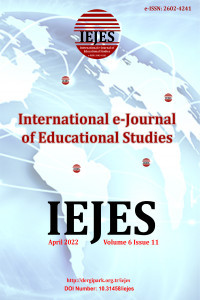Distance Education Competencies of Physical Education Teachers: Elazığ Province
The purpose of this research; The aim of this study is to examine whether the distance education competencies of physical education teachers working in Elazig differ in terms of different variables. The universe of the study consists of physical education teachers working in the province of Elazig in Turkey, while the sample consists of 155 physical education teachers selected by random method. In the research, which was prepared in a 5-point likert type consisting of a personal information form and 18 items, in order to collect data in the research; Physical Education Teachers’ Distance Education Competencies Scale was used. According to the research findings, 69.7% of the participants are male, 52.9% are 36-45 years old, 78.1% are married, 54.8% are at school level, 31.0% are 16-20 years. seen as. When we look at the analysis of variance according to the age and seniority of the participants, it was seen that there was a significant difference between the groups. In conclusion; When the Distance Education Competencies of Physical Education Teachers were examined, it was seen that the distance education competencies of the teachers decreased as the age and professional seniority of the teachers increased.
Anahtar Kelimeler:
Distance education, covid-19, physical education, teacher
Distance Education Competencies of Physical Education Teachers: Elazığ Province
The purpose of this research; The aim of this study is to examine whether the distance education competencies of physical education teachers working in Elazig differ in terms of different variables. The universe of the study consists of physical education teachers working in the province of Elazig in Turkey, while the sample consists of 155 physical education teachers selected by random method. In the research, which was prepared in a 5-point likert type consisting of a personal information form and 18 items, in order to collect data in the research; Physical Education Teachers’ Distance Education Competencies Scale was used. According to the research findings, 69.7% of the participants are male, 52.9% are 36-45 years old, 78.1% are married, 54.8% are at school level, 31.0% are 16-20 years. seen as. When we look at the analysis of variance according to the age and seniority of the participants, it was seen that there was a significant difference between the groups. In conclusion; When the Distance Education Competencies of Physical Education Teachers were examined, it was seen that the distance education competencies of the teachers decreased as the age and professional seniority of the teachers increased.
Keywords:
Distance education, covid-19, physical education, teacher,
___
- Altiparmak, M., Kurt, I. D., & Kapidere, M. (2011, February). Open source learning management systems in e-learning and distance education. Academic Informatics’11 - XIII. Academic Informatics Conference Proceedings 2 - 4 February 2011 İnönü University, Malatya.
- Aras, L. & Işık M. A. (2020). Evaluation of distance education and live lesson activities. Access address http://www.bedenegitimi.gen.tr/haber/uzaktan-egitim-ve-canli-ders-faaliyetlerin-degerlenen-h12386.html
- Bandura, A. (1994). Self-efficacy. encyclopedia of human behavior, 4, 71-81. NY: AcademicPress
- Demir, G. T., Cicioğlu, H. İ., & İlhan, E. L. (2020). Athlete’s anxiety to catch the novel coronavirus (covid-19) scale (AACNCS): Validity and reliability study: Journal of Human Sciences, 17(2), 458-468.
- Demirci, A. (2008). Laboratory studies in geography teaching. Demirci, A., Özey, R. (Editors), Methods and approaches in teaching geography (p. 57-76). Istanbul: Aktif Publishing House
- Goddard, RD, Hoy, WK &Woolfolk Hoy, A. (2000). Collective efficacy: Its meaning, measure, and impact on student achievement. American Journal of Educational Research, 37, 479-507.
- Jannah, M., Prasojo, L. D., & Jerusalem, M. A. (2020). “Elementary school teachers’ perceptions of digital technology based learning in the 21st century: Promoting digital technology as the proponent learning tools”. Journal Pendidikan Guru MI, 7(1), 1-18.
- Kocasaraç, H. (2003). Teacher competencies regarding the use of computers in teaching. The Turkish Online Journal of Educational Technology-TOJET, 2(3), 77-86.
- Küçük, D., & Can, F. (2020). Stance detection: A survey. ACM Computing Surveys, 53(1), 1-37. Ministry of National Education. (2020). COVID-19 (SARS-CoV2 Infection) Guide. Access: https://covid19bilgi.health.gov.en/repository/guides/COVID-19_Guide.pdf (Access Date: 16.07. 2020).
- Özcan, B. & Saraç, L. (2020). Teacher online distance education roles and competencies during the covid-19 pandemic: The example of physical education teachers. Journal of National Education, 459-475. https://doi.org/10.37669/milliegitim.787127
- Sağın, A. E., Yücekaya., M. A. & Güllü, M. (2021). Physical education teachers’ distance education competencies scale: A scale development study. Journal of Sport and Performance Research, 12(2), 200-21. https://doi.org/10.17155/omuspd.839314
- Solak, H. İ., Utebay, G., & Yalçın, B. (2020). Comparison of the exam success of distance education students in print and digital media. Journal of Open Education Practices and Research, 6(1), 41-52.
- Başlangıç: 2017
- Yayıncı: Tamer KUTLUCA
Sayıdaki Diğer Makaleler
Assessment of Mobile Phone Usage and Loneliness Levels of Faculty of Sports Sciences Students
Süreyya Yonca SEZER, Kubilay ŞENBAKAR
Seventh-Grade Students’ Perspective on Non-Governmental Organization
Distance Education Competencies of Physical Education Teachers: Elazığ Province
Oğuzhan ALTUNGÜL, Didem YAVUZ SÖYLER
Examination of Foreign Students’ Anxiety in Learning Turkish in Terms of Various Variables
Peer Bullying Experiences and Management Strategies of Preschool Teachers
Examining the Learning Styles of Teacher Candidates in Terms of Different Variables
Betül KÜÇÜK-DEMİR, Demet DENİZ YILMAZ
Tuba YENİL, Burçin GÖKKURT ÖZDEMİR
